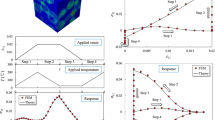Abstract
Particulate composites with polymer matrix are used in engineering applications, such as solid propellants, industrial rubbers and road pavements. The durability of such materials critically depend on the characterization of mechanical property degradation. Mechanical damage studies of these composites thus become important. A phenomenological model describing the mechanical damage in polymer matrix is developed in the present work, where the polymer is modelled as a viscoelastic (VE) solid and the damage is characterized by the progressive degradation of storage modulus. This VE model, with two term Prony series approximation of the relaxation modulus, is then coupled with isotropic damage formulation. Two approaches of isotropic damage evolution, viz. explicit and implicit, are implemented accounting the irreversible thermodynamic considerations. The implicit isotropic damage evolution is derived by a dissipation potential function based on the effective elastic stored energy density. An exponential damage evolution, obtained from experiments, is adapted in explicit approach. The analytical VE-damage framework is numerically implemented as stress integration algorithm, and the corresponding simulation results are illustrated. It is seen from the formulation and results that, the damage implicitly affects the relaxation time of the polymer. The stress hardening behaviour occuring immediately after the damage initiation is captured, and the subsequent softening is also demonstrated.









Similar content being viewed by others
References
Farris, R.: The character of the stress-strain function for solid propellants. Trans. Soc. Rheol. 60(2), 153–173 (1968)
Farris, R.: The stress-strain behavior of mechanically degradable polymers. Structural and Mechanical Properties, Polymer Networks (1971)
Ha, K., Schapery, R.: A three-dimensional viscoelastic constitutive model for particulate composites with growing damage and its experimental validation. Int. J. Solids Struct. 35(26–27), 3497–3517 (1998)
Park, S.W., Schapery, R.: A viscoelastic constitutive model for particulate composites with growing damage. Int. J. Solids Struct. 34(8), 931–947 (1997)
Şebnem Özüpek, E.B.: Becker, Constitutive equations for solid propellants. J. Eng. Mater. Technol. 119(2), 125–132 (1997)
Jung, G.-D., Youn, S.-K.: A nonlinear viscoelastic constitutive model of solid propellant. Int. J. Solids Struct. 37(34), 4715–4732 (1999)
Matouš, K., Inglis, H., Gu, X., Rypl, D., Jackson, T., Geubelle, P.: Multiscale modeling of solid propellants: from particle packing to failure. Compos. Sci. Technol. 67(7–8), 1694–1708 (2007)
Trombini, M., Nadot-Martin, C., Halm, D., Gueguen, M., Contesse, G., Fanget, A.: Multiscale damage modeling with the morphological approach to highlight particle size and interaction effects in highly-filled particulate composites. Eur. J. Mech. A/Solids 53, 163–174 (2015)
Aigner, E., Lackner, R., Pichler, C.: Multiscale prediction of viscoelastic properties of asphalt concrete. J. Materi. Civ. Eng. 21(12), 771–780 (2009)
Londono, J.G., Shen, R., Waisman, H.: Temperature-dependent viscoelastic model for asphaltconcrete implemented within a novel nonlocal damage framework. ASCE J. Eng. Mech. 146(2), 04019119 (2020)
Nedjar, B., Roy, R.L.: An approach to the modeling of viscoelastic damage: application to the long- term creep of gypsum rock materials. Int. J. Num. Anal. Methods Geomech. 37(9), 1066–1078 (2013)
Simo, J., Hughes, T.: Computational Inelasticity. Springer, Berlin (1998)
Murakami, S.: Continuum Damage Mechanics. Springer, Berlin (2012)
Simo, J.C.: On a fully three-dimensional finite-strain viscoelastic damage model: fomulation and computational aspects. Comput. Methods Appl. Mech. Eng. 60(2), 153–173 (1987)
Christensen, R.M.: Theory of Viscoelasticity: an introduction. Academic Press (1982)
Lemaitre, J.: A Course on Damage Mechanics. Springer, Berlin (1992)
Jirásek, M., Marfia, S.: Non-local damage model based on displacement averaging. Int. J. Num. Methods Eng. 63(1), 77–102 (2005)
Huiru, C., Tang, G., Shen, Z.: A three-dimensional viscoelastic constitutive model of solid propellant considering viscoelastic poisson’s ratio and its implementation. Eur. J. Mech. A/Solids 61, 235–244 (2017)
Acknowledgements
The authors gratefully acknowledge the financial support provided by Armament Research Board, India under project number ARMREB/HEM/2017/193.
Author information
Authors and Affiliations
Corresponding author
Additional information
Publisher's Note
Springer Nature remains neutral with regard to jurisdictional claims in published maps and institutional affiliations.
Appendix
Appendix
Calculation of stress with N-term Prony series
The formulae needed to calculate stress in case of tensile relaxation modulus aproximated by N-term Prony series is given below :
Current stress \(\sigma _{n+1}\) is given by
where
The (linear) elastic strain energy density \(W^{o}(\epsilon _{n+1})\) can be approximated by
where the instantaneous elastic modulus \(E_{o}\) is
Rights and permissions
About this article
Cite this article
Hegde, M., Mulay, S.S. An approach to model mechanical damage in particulate composites with viscoelastic matrix. Int J Adv Eng Sci Appl Math 13, 79–88 (2021). https://doi.org/10.1007/s12572-021-00289-7
Accepted:
Published:
Issue Date:
DOI: https://doi.org/10.1007/s12572-021-00289-7




